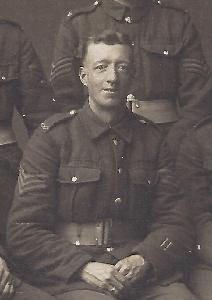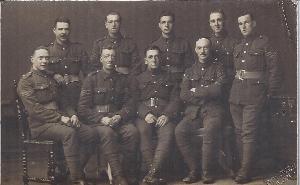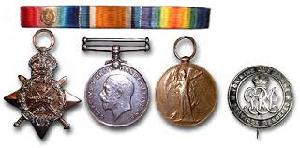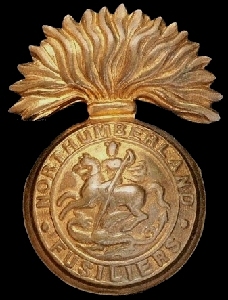
George Edward Hunter

N.C.Os

G.E. Hunter's service medals

Northumberland Fusiliers Badge
Northumberland Fusiliers
12th (Service) Battalion 1914 – 1917
3rd (Reserve) Battalion 1917 – 1918
George Edward Hunter was born December 1895 at Chevington, Northumberland. He was the son of John George and Mary Hunter and the younger brother of John James Hunter.
On 28/08/1914, he enlisted in the Northumberland Fusiliers at Newcastle-on-Tyne, aged 19 years + 9 months, occupation Miner.
George Edward Hunter was posted to 12th Northumberland Fusiliers, a Kitchener “New Army” (Service) battalion raised in Newcastle in September 1914 and forming up at Halton Park, near Tring Hertfordshire, as part of 62nd Brigade / 21st Division. In Nov. 1914, he went to billets in the Aylesbury Buckinghamshire area. During May 1915 he returned to Halton Park for training. The following month saw him appointed as a Lance Corporal and he continued his training at Witley in Surry in August of that year. George Edward Hunter disembarked with his battalion in France on 9.9.1915.
Battles and Engagements of 21st Division, Western Front September 1915 – June 1917
25-26 Sep. 1915: Battle of Loos (XI Corps / First Army).
July – Oct. 1916 Battles of the Somme, including the first fateful day of July 1st. (XV Corps / Fourth Army).
15/04/1916: To 64th Field Ambulance suffering from scabies.
24/04/1916: Admitted to 22nd Field Ambulance.
12/06/1916: GSW (gunshot wound) to the knee, admitted to 21st Casualty Clearing Station.
29/09/1916: Appointed Acting Sergeant.
16/08/1916: Reduced to Acting Corporal (Battles of the Somme end in October).
14.2.1917: Reverted to appointment of Lance Corporal.
29 March – 5 April 1917: German Retreat to the Hindenburg Line (VII Corps / Third Army).
9 April – 4 May 1917: Battles of Arras (VII Corps / Third Army).
31 May – 16 June 1917: Actions on the Hindenburg Line (VII Corps / Third Army).
16 June 1917: Last day of the above battle, GSW (gunshot wound, but actually a piece of shrapnel as per his medical report) in the left ankle at Bullecourt and taken to 3rd Australian Casualty Clearing Station.
21/06/1917: Departs France for treatment in UK.
22/06/1917: On strength of Regimental Command Depot N.F. at Alnwick and treated at 2nd Stationary Hospital Exeter, duration three months.
13/09/1917: Reports for duty at the Regimental Depot, Alnwick.
15/01/1918: Posted to 3rd (Reserve) Battalion N. F. based at East Boldon, South Tyneside.
31/01/1918: Deprived of appointment of Lance Corporal and reverts to his substrative rank of Private. 05/02/1918: Re-appointed to Lance Corporal. 22/06/1918: Appointed to Acting Corporal.
02/08/1918: Attended army medical examination for disability assessment and potential discharge on medical grounds (wounds). Complained about pain and stiffness in left ankle resulting in not being able to march. Disability assessed at 20% disablement, permanent (then changed to not permanent) and a one-off award of £28.0.0 made. Conclusion is that George will no longer be an efficient soldier, but recommendation for discharge not made, nevertheless five weeks later George is discharged to the Army ‘P’ Reserve.
05/09/1918: Discharged to the Army ‘P’ Reserve (reserve occupation, in this case coal mining) and transferred to civilian work with the Netherton Colliery Co., Newcastle.
George Edward Hunter was in the Home Theatre from 28.8.1914 to 8.9.1915. Between 9.9.1915 and 21.6.1917 he was with the British Expeditionary Force (BEF) in France. From 22.6.1917 to 5.9.1918 he was in the Home Theatre. He was awarded the following medals;
The 1914/15 Star,
British War Medal
Victory Medal.
Silver War Badge No- B179389.
Shown here is a typical photograph of senior NCO’s of similar rank posing in a professional studio to celebrate the ending of WW1 hostilities before they all go their separate ways. This timing is based on the small inverted Overseas Service Chevrons (aka Stripes) worn on the lower right arm, which were not introduced until early 1918 plus their clean uniforms and calm pose.
George Edward Hunter was one of four brothers who enlisted. His youngest brother Isaac Whitfield Hunter died in 1917 from injuries. George married Margaret Mollie McGlen in 1919 and they had two children Margaret Peggy Hunter and John George Hunter. After working in the coal mines he became a shopkeeper and had a shop in the east end of Bedlington near to Bedlington Bank. He died aged 68 in 1963.
The information about this brave person was compiled by Derek Johnstone using information from his family tree. Thanks must go to Australian researcher Graham Caldwell for providing the detailed military information and solving many unanswered questions.
Sources Used to Reconstruct George Edward Hunter’s WW1 Service RecordGeorge E Hunter’s duplicate service record and medical record in TNA WO 364 Army Pensions (Ancestry.co.uk)./>WW1 Soldier’s Medal Index Cards.
Silver War Badge Roll.
James, Brigadier E.A. “British Regiments 1914-1918”; Naval & Military Press reprint 1998 for activity of 12/N.F. from formation to going overseas.
Becke, Major A. F. “Order of Battle of Divisions of the Great War” (Part 3 The New Army Divisions); Naval & Military Press reprint for engagements on the Western Front.
Johnstone family knowledge and photograph.
George Edward Hunter’s name appears on page 113 of Bedlington Book of Enlistments

